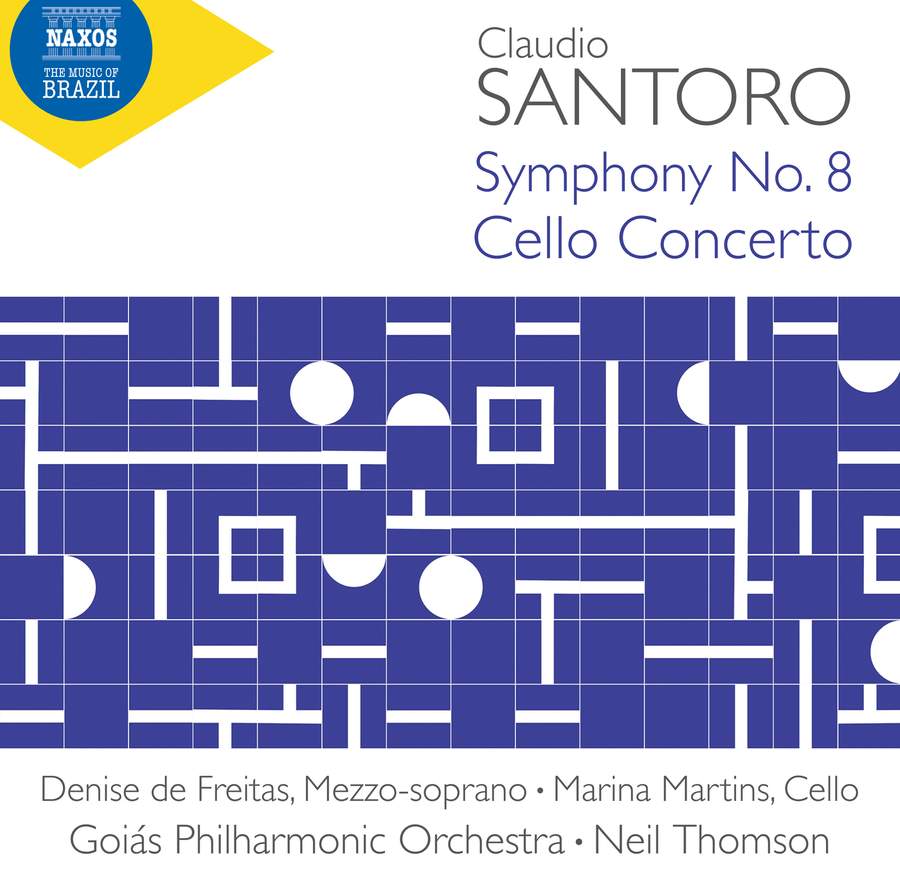SANTORO Symphony No 8. Cello Concerto (Marina Martins)
View record and artist detailsRecord and Artist Details
Genre:
Orchestral
Label: Naxos
Magazine Review Date: 11/2023
Media Format: CD or Download
Media Runtime: 67
Mastering:
DDD
Catalogue Number: 8 574410

Tracks:
| Composition | Artist Credit |
|---|---|
| Cello Concerto |
Cláudio Santoro, Composer
Goiás Philharmonic Orchestra Marina Martins, Cello Neil Thomson, Conductor |
| Symphony No 8 |
Cláudio Santoro, Composer
Denise de Freitas, Mezzo soprano Goiás Philharmonic Orchestra Neil Thomson, Conductor |
| Três Abstrações |
Cláudio Santoro, Composer
Goiás Philharmonic Orchestra Neil Thomson, Conductor |
| Interações assintóticas |
Cláudio Santoro, Composer
Goiás Philharmonic Orchestra Neil Thomson, Conductor |
Author: Andrew Farach-Colton
This entry in Naxos’s survey of Claudio Santoro’s symphonies and orchestral music brings us to the 1960s and the Brazilian composer’s experimentations with serialism, microtonality, indeterminacy and other techniques of that era. Because Santoro has such a sure sense of drama in his abstract music – as Ivan Moody noted in his review of the 11th and 12th Symphonies (Naxos, 1/23) – there’s nothing arid or purely academic in any of these works, although there are quite a few passages that now sound rather generically modernist, as in the clouds of tone clusters and scurrying, insect-like motion in the aphoristic Three Abstractions of 1966.
In the compact Eighth Symphony (1963), Santoro generally restricts his lyrical impulses to tiny phrases, creating a kind of mosaic. Yet there are moments, too, when he allows a phrase to expand, as at 3'30" in the first movement, where a solo oboe arches over a spare accompaniment in the strings. The second movement features a wordless lament from a mezzo-soprano – achingly sung here by Denise de Freitas, who vaults over awkward intervals with complete confidence – while the finale’s jagged rhythms cut a Stravinskian profile. Does it all add up in the end? I’m not quite sure – the ending feels abrupt – but it’s consistently engaging nonetheless.
Santoro composed Asymptotic Interactions in 1969 while living in Paris with a physicist friend. I’m always wary when composers attempt to translate scientific or mathematical concepts into music, and here, I can’t quite connect Santoro’s work with asymptotic behaviour (lines that get closer and closer to a curve as the distance gets closer to infinity). What I find alluring, though, are the sonorities (he has half the string section tuned a quarter-tone lower) and the work’s strong dramatic shape. Note, for example, how the bottom seems to fall out of the music at 3'04", and how he builds to an ending that, for once, feels satisfyingly conclusive.
The Cello Concerto (1961) is the most valuable prize here, however. Composed in Berlin around the time of the construction of the Berlin Wall, its darkly brooding atmosphere reminds me of Frank Bridge’s Oration. Yet, while the language is stark and bleakly expressionistic, Santoro’s lyricism pours forth in gushes of inspiration. The solo cello doesn’t enter until five and a half minutes into the first movement, yet once present it leads the way, seemingly striving and struggling against tremendous odds. Listen, say, to the opening of the finale, where the cello seems to be preparing for battle over marchlike rhythms in the orchestra.
Marina Martins plays the solo part with expressive power and technical finesse, and the Goiás Philharmonic play brilliantly for Neil Thomson throughout the entirety of this challenging programme. Of all the works I’ve heard by Santoro thus far, his Cello Concerto is the most deserving of a place in the repertoire.
Discover the world's largest classical music catalogue with Presto Music.

Gramophone Digital Club
- Digital Edition
- Digital Archive
- Reviews Database
- Full website access
From £8.75 / month
Subscribe
Gramophone Full Club
- Print Edition
- Digital Edition
- Digital Archive
- Reviews Database
- Full website access
From £11.00 / month
Subscribe
If you are a library, university or other organisation that would be interested in an institutional subscription to Gramophone please click here for further information.




